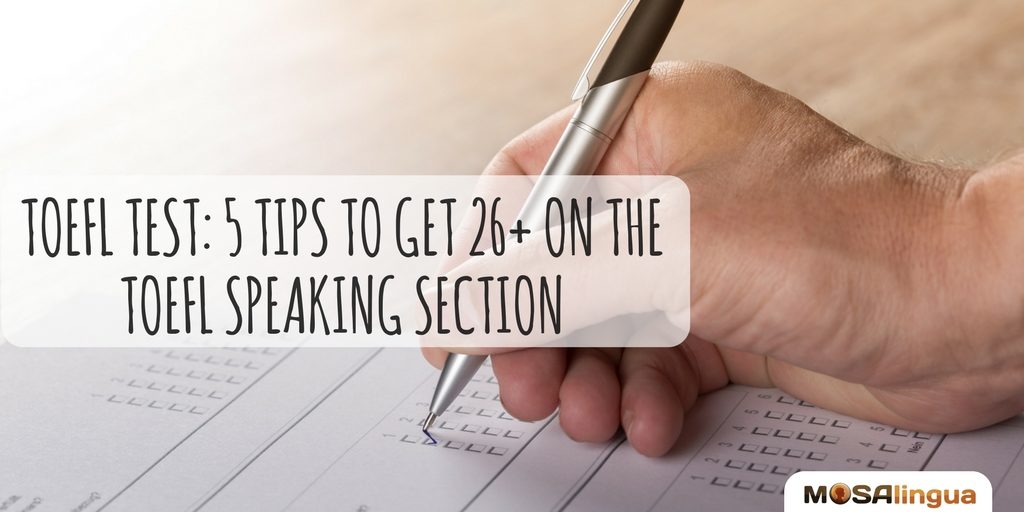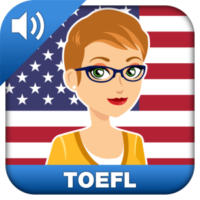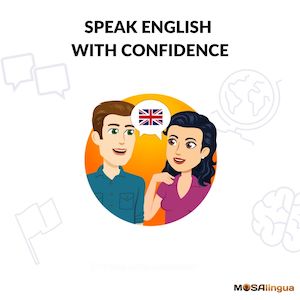Here at MosaLingua, we have already talked about the TOEFL giving 5 tips to pass this popular English test. In today’s post, our guest blogger Paul Austin, a TOEFL speaking teacher, is going to address the most difficult part of the TOEFL test – the speaking section – and give you five tips on HOW you can master the speaking section and get a score of 26+.

1. Understand How To Answer Each Question
There are six different types of questions on the TOEFL Speaking section.
The first two questions are open-ended, while the last four questions require you to read a passage and/or listen to a lecture or dialogue.
If you want to do well on every question, you MUST understand how to:
- Take notes on the reading and listening passages
- Organize your note structure
- Prepare for your response
- Give your response.
2. Give Yourself Plenty of Time to Study

If you plan to take TOEFL, it’s VERY important to give yourself at least 4 weeks to study.
If you try to fit all your studying into just one or two weeks, it will be very difficult to learn all the tips and strategies about TOEFL speaking and still get a high score.
Why is this?
Cramming information is not an effective way to learn a new language. Instead, a new language must be learned through a consistent study program that gradually introduces new material while reviewing old material at a slow pace.
Two months is a reasonable amount of time to study to be prepared for this test.
This length of time allows the student to learn about every important aspect of the TOEFL Speaking section – things like pronunciation, learning ‘native phrases’ and reducing ‘umm’s’ and ‘uhh’s’.
3. Create a TOEFL Speaking Schedule
The number one way to keep yourself accountable and consistently study TOEFL Speaking is by writing out a schedule.
Without words written down on paper or a schedule saved in Google calendar, you will be much more likely to avoid studying and seek out distractions.
Distracting activities will NOT help you achieve your TOEFL Speaking Goals.
So you must create a schedule and follow it as close as possible. If you do this, mastering the TOEFL Speaking section will be MUCH easier because distractions will not bother you.
For an example of a TOEFL Speaking schedule, check out this post I created: TOEFL Speaking Schedule
4. Sound More Like a Native!
You don’t need to sound 100% like a native English speaker – that would be nearly impossible for any ESL learner!
But you should do two things to improve your speech:
- Reduce your umm’s and uhh’s:
When native speakers talk to each other in everyday conversation, ‘umm’s’ and ‘uhh’s’ are very uncommon. And one of the ways you are graded for TOEFL Speaking is your ability to sound like a native speaker.
For this reason, it’s important to reduce the amount of ‘umm’s’ and ‘uhh’s’ you use.
How can you do this?
Record yourself speaking. Play the recording back and count how many um’s you said. Record yourself speaking again. Try to reduce the number of um’s. Listen to the 2nd recording. Continue this process until you’ve reduced your ‘umm’s’ and ‘uhh’s’ to 2-3 per 60 seconds.
- Master pronunciation for seven words
- This (to practice the ð sound)
- Think (to practice the θ sound)
- Have (to practice the h sound)
- Were (to practice the r sound)
- Wanted / Learned / Played (to practice the 3 different ways of pronouncing the final -ed sound: -id, -t, -d)
Phew! I know – there are a lot of words/phrases here to memorize, but if you can master the pronunciation of these SEVEN words, that will help your score tremendously.
Why these seven? Because these words are not only used very often in the speaking section, but they also contain the sounds that seem to be harder for English learners.
So, if you focus on mastering the pronunciation of the most common words and sounds, you will sound even MORE like a native when you speak (again, back to the 80/20 principle)
5. Practice, Practice, Practice
The only way to improve your speaking ability in a foreign language is to practice speaking. Remember, TOEFL Speaking is really just a test to measure your English speaking ability. The more you practice speaking English, and the more you practice responses specific to the TOEFL Speaking section, the faster you will improve.
I have 2 final recommendations for TOEFL speaking practice:
- Join a TOEFL speaking partner group – This is a great way to prepare for the TOEFL Speaking section. By joining a TOEFL Speaking Partner group, you connect with other individuals who are also preparing for the TOEFL Speaking section. You meet over Skype for an hour or so, and each of you spends 30 minutes giving responses for the TOEFL Speaking section. I’ve created a Facebook group to help people like you find a partner: TOEFL Speaking Partner
- Record your answers – One way to practice for TOEFL Speaking is to record your responses to the TOEFL Speaking questions. Once your answer is recorded, you can do 1 of 2 things. First, you can upload your answer to a website and receive feedback from qualified instructors. One great place to do this is TOEFL-Speaking. You can also listen to and analyze your responses, and determine what didn’t go well and what you need to fix.
The author of this blog post is Paul Austin. He specializes in helping students master the TOEFL Speaking section at his website TOEFL Speaking Teacher.
MosaLingua TOEFL Vocabulary Trainer

MosaLingua TOEFL Vocabulary Trainer helps you memorize the most useful words to know to pass this test with flying colors.
It contains more than 2000 words with synonyms, definitions, examples, and pronunciation and it uses our effective method MosaLearning.
Download the app for Android on Google Play and for iPhone/iPad on iTunes
Related posts:
Want to start improving your language skills today?
Improve your spoken English

Good news: we have a course for that: the Speak English with Confidence MasterClass.
It’s a comprehensive 10-module course designed to help you improve every aspect of your spoken English – fluency, confidence, pronunciation, and more – step by step, and enjoy doing it.








Comments